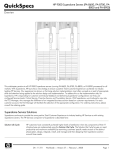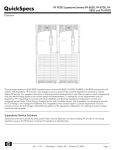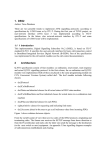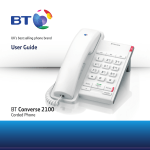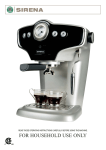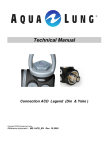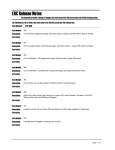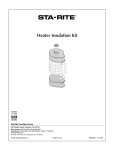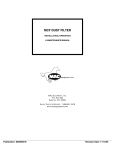Download Standard Shell & Tube IOM Manual
Transcript
SERVICE MANUAL Installation, Operation and Maintenance Manual for Standrd Pre-Engineered Shell & Tube Models BCF, HCF, HFF, SSCF & SX2000 Fixed Tube Sheet Heat Exchangers For Service & Parts please call APK THERMAL at 519-858-0976 or email [email protected] SAFETY INSTRUCTION This safety alert symbol will be used in this manual to draw attention to safety related instructions. When used, the safety alert symbol means ATTENTION! BECOME ALERT! YOUR SAFETY IS INVOLVED! FAILURE TO FOLLOW THESE INSTRUCTIONS MAY RESULT IN A SAFETY HAZARD. p.1 12. Location of the operating fluids in the heat exchanger can be a function of the application. A few tips for the location of the operating fluids are: a. As a cooler, the preferred arrangement is with the hot medium through the shell and the cooling medium through the tubes. When the hot fluid is dirty or fouling, it is better to put it through the tubes because they are easier to clean. With single pass units be sure the shell inlet is on the same end as the tube side outlet. In two pass units, the shell inlet should be at the inlet-outlet bonnet end. It is customary for the cooling medium to enter the lower bonnet connection, although this can be reversed if necessary. b. As a heater, the hot medium, usually steam or hot water, must be in the shell. If it is steam, either of the shell connections, or both, can be used, dependent on the actual entering velocities. INSTALLATION 11. Before installing this equipment, environment and service conditions should be checked for compatibility with materials of construction. Contact your nearest ITT Standard Representative if you are not sure what the actual materials of construction are. 12. Provide valves and by-passes in the piping system so that both the shell and tube sides may be by-passed to permit inspection or repair. 13. Provide thermometer well and pressure gauge connections in all piping to and from the unit and locate as near the unit as possible. 14. Provide convenient means for frequently cleaning the unit as suggested under “Maintenance.” 15. Provide necessary air vent cocks for units so they can be purged to prevent or relieve vapor or gas binding of either the tube or the shell sides. 16. Foundations must be adequate so that exchangers will not settle and cause piping strains. Foundation bolts should be set to allow for setting inaccuracies. In concrete footings, pipe sleeves at least one size larger than bolt diameter slipped over the bolt and cast in place are best for this purpose, as they allow the bolt center to be adjusted after the foundation has set. 17. Loosen foundation bolts at one end of unit to allow free expansion of shells. Oval holes in foundation brackets are provided for this purpose. 18. Set exchangers level and square so that pipe connections may be made without forcing. 19. Inspect all openings in exchanger for foreign material. Remove all thread protectors and shipping pads just before installing. Do not expose units to the elements with pads or other covers removed from openings since rain water may enter the unit and cause severe damage due to freezing. 10. Be sure the entire system is clean before starting operation to prevent plugging of tubes with sand or refuse. The use of strainers in settling tanks in pipe lines leading to the unit is recommended. 11. Drain connections should not be piped to a common closed manifold. p.2 c. For the above applications and for temperatures above 150°F, the higher temperature fluid should be circulated through the shell side of the exchanger and precaution should be taken to avoid shock from abrupt changes in fluid circulation temperatures. 13. Steam hammer can cause serious damage to the tubes of any heat exchanger. A careful consideration of the following points before an installation is made can prevent costly repairs which may be caused by steam hammer. a. A vacuum breaker and/or vent, should be used in accordance with the type of steam system installed. b. The proper trap for the steam system installed should be used. c. The trap and the condensate return line to the trap should be properly sized for the total capacity of the convertor. d. The trap should be sized for the pressure at the trap, not the inlet pressure to the steam controller. e. The trap must drain into an unpressurized condensate return system. Condensate return lines must not be run at an elevation above the bottom of the heat exchanger. To do so may result in a buildup of the condensate level in the heat exchanger, which could cause water hammer and damaged tubes. CAUTION: During times of shutdown, volumetric expansion can occur. We recommend the installation of a properly sized relief valve on both sides of the heat exchanger. OPERATION 1. When placing a unit in operation, open the vent connections and start to circulate the cold medium only. Be sure that the passages in the exchanger are entirely filled with the cold fluid before closing the vents. The hot medium should then be introduced gradually until all passages are filled with liquid, close vents and slowly bring the unit up to temperature. 2. Start operation gradually. Do not admit hot fluid to the unit suddenly when empty or cold. Do not shock unit with cold fluid when unit is hot. CAUTION: Fluids must be gradually introduced to the unit. Failure to do so can cause damage to the heat exchanger. 3. In shutting down, flow of hot medium should be shut off first. If it is necessary to stop circulation of cooling medium the circulation of hot medium should also be stopped by by-passing or otherwise. 4. Do not operate equipment under conditions in excess of those specified on nameplate. WARNING: Failure to operate the heat exchanger within the design pressure and temperature on the nameplate may result in damage to the heat exchanger and potential injury to adjacent personnel. 5. Drain all fluids when shutting down to eliminate possibility of freezing and corrosion. To guard against water hammer, condensate should be drained from steam heaters and similar apparatus both when starting up and when shutting down. 6. In all installations there should be no pulsation of fluids since this causes vibration and strain with resulting leaks. 7. All gasketed joints should be checked after starting for leaks and tightened if necessary. WARNING: The HCF and SSCF exchangers are suit able for use as heaters using steam as the heating medium. These exchangers are, however, fixed tubesheet units and, therefore, not designed to absorb thermal shock inherent in the intermittant service of on and off heating with frequent short intervals of demand. Their recommended use is where service is continuous or steady, with relatively long periods between shutdown and start-up. Heat exchanger failure due to thermal shock may result in potential personal injury. 5. Do not blow out heat exchangers with air when operating fluids are of a flammable or otherwise hazardous nature. WARNING: Proper precautions must be taken (special clothing, equipment, etc.) to protect personnel from injury due to escaping fluids. 6. Provide convenient means for frequently cleaning heat exchangers as suggested below: a. Circulating hot wash oil or light distillate through tubes or shell at good velocity will effectually remove sludge or other similar soft deposits. b. Soft salt deposits may be washed out by circulating hot fresh water. c. Some cleaning compounds on the market, such as “Oakite” may be used to advantage for removing sludge or coke, provided hot wash oil or water, as described above, does not give satisfactory results. d. If none of the above described methods are effective for the removal of hard scale or coke a mechanical means may be used. The interior of the tubes may be rodded. e. The exterior or shell side of the tubes of a fixed sheet heat exchanger can only be cleaned chemically by using a chemical dissolved in water solution. We suggest that the user contact the manufacturer of the cleaning chemical for instructions. WARNING: Care must be exercised when handling certain fluids. Follow manufacturers instructions. Use eye and skin protection. Wear a respirator when required. MAINTENANCE 1. Do not open heads until all pressure is off equipment and the unit is drained. 2. Remove the bonnets. Inspect all tubes carefully for possible erosion, corrosion, or foreign material. 3. Inspect all anodes to be sure they are neither excessively corroded nor insulated with scale. Scrape to a bright surface. 4. Inspect filters in the system to prevent foreign matter from entering the exchanger. p.3 1/4" 7. When replacing heads, use a torque wrench.* Tighten diameter bolts (2” diameter units) to 6 ft-lbs., 5/16" diameter bolts (3" & 4" diameter units) to 16 ft-lbs., and 3/8" diameter bolts (5", 6", & 8" diameter units) to 24 ft-lbs. If the gasket joint still leaks, tighten in 2 ft-lb. increments until leak stops. *The above torque values apply to well lubricated nut bearing *surfaces. 8. All bolted joints should be tightened uniformly and in a diametrically staggered pattern as illustrated below: START 1 16 6 11 9 8 14 3 4 13 10. Exchangers subject to fouling or scaling should be cleaned periodically. A light sludge or scale coating on the tube greatly reduces its effectiveness. Therefore, low-fouling fluids should be used in the shell side of all heat exchangers with nonremovable tube bundles. A marked increase in pressure drop and/or reduction in performance usually indicates cleaning is necessary, especially if the unit has been checked for air or vapor binding and this has been found not to be the cause. Since the difficulty of cleaning increases rapidly as the scale thickens or deposits increase, the interval between cleanings should not be excessive. 10 7 12 5 15 2 9. Frequently and at regular intervals, observe interior and exterior condition of all tubes and keep them clean. Frequency of cleaning should be according to scale build-up. CAUTION: Neglect in keeping all tubes clean may result in complete stoppage of flow through some tubes with consequent overheating of these tubes, resulting in severe expansion strains, leaking tube joints, and damage to the heat exchanger. FRONT HEAD GASKET FRONT HEAD ANODES 1. Some exchangers may be equipped with renewable anodes. The purpose of the anodes is to inhibit electrolytic corrosion. In order to remain active the anodes must be kept free of scale or other surfaces coatings. 2. On some applications where electrolytic corrosion is not a problem, pipe plugs may be substituted for the anode. The pipe plug material selected should be softer than the base part to avoid pipe thread damage. CORE (BUNDLE & SHELL ASSEMBLY) REAR HEAD REAR HEAD GASKET RENEWABLE ANODES (ZINC) MOUNTING LEGS For further information, contact APK Thermal, 131 Masonville Cres., London, ON N5X 3T1 Phone (519) 858-0976; FAX (519) 858-9701 Email: [email protected] p.4 ORIGINALLY PRINTED IN U.S.A. 6-1995 Updated 7-2012 Model BCF/HCF cross-section view – Brass shell, tube sheets & baffles, Copper tubes, Cast Iron bonnet headers. Model SSCF/SSCF-C/SSCF-K: all SS316 construction. Do you need replaceemnt exchanger? Please call APK Thermal at 519-858-0976 or emial [email protected] p.5





